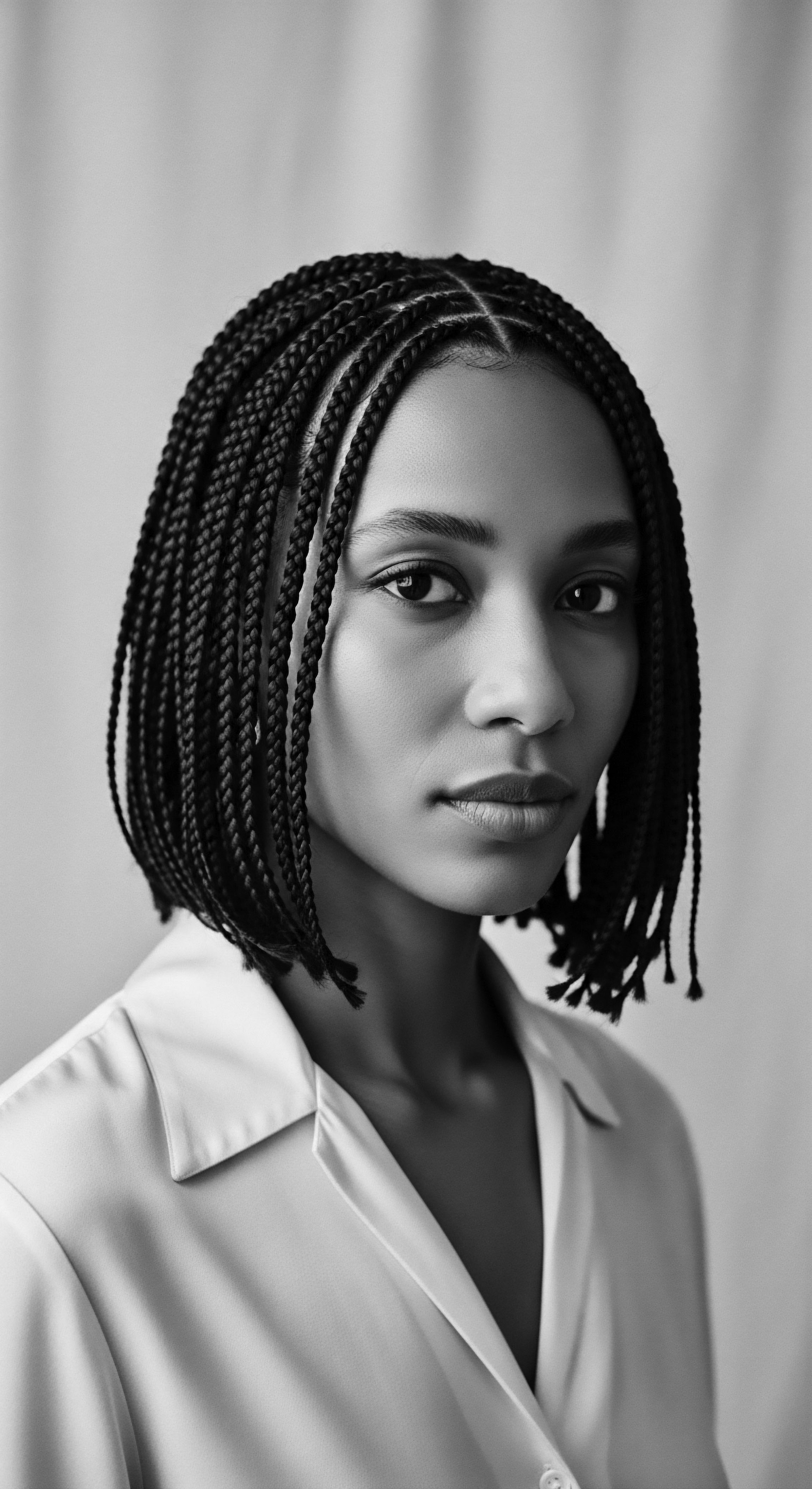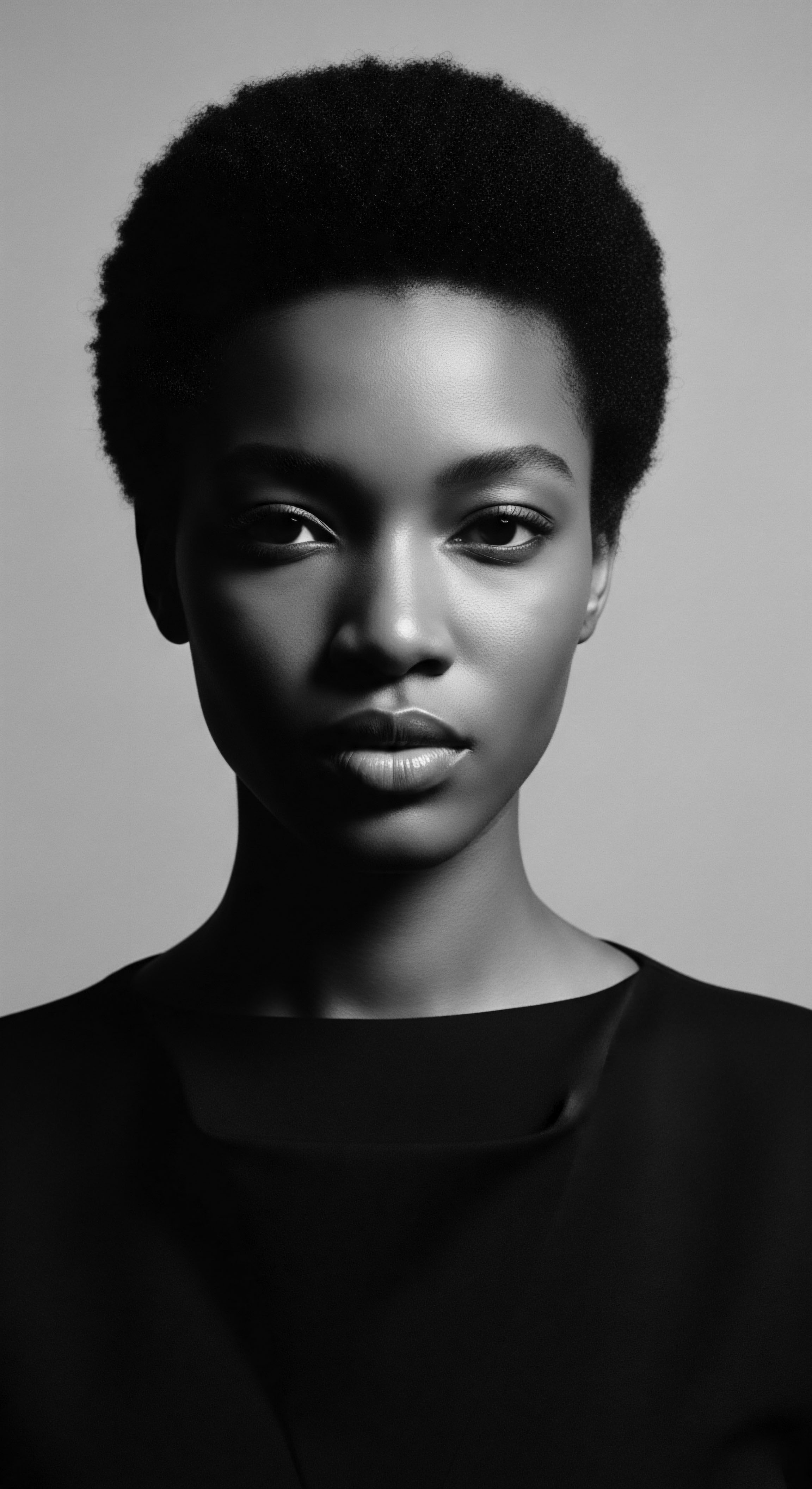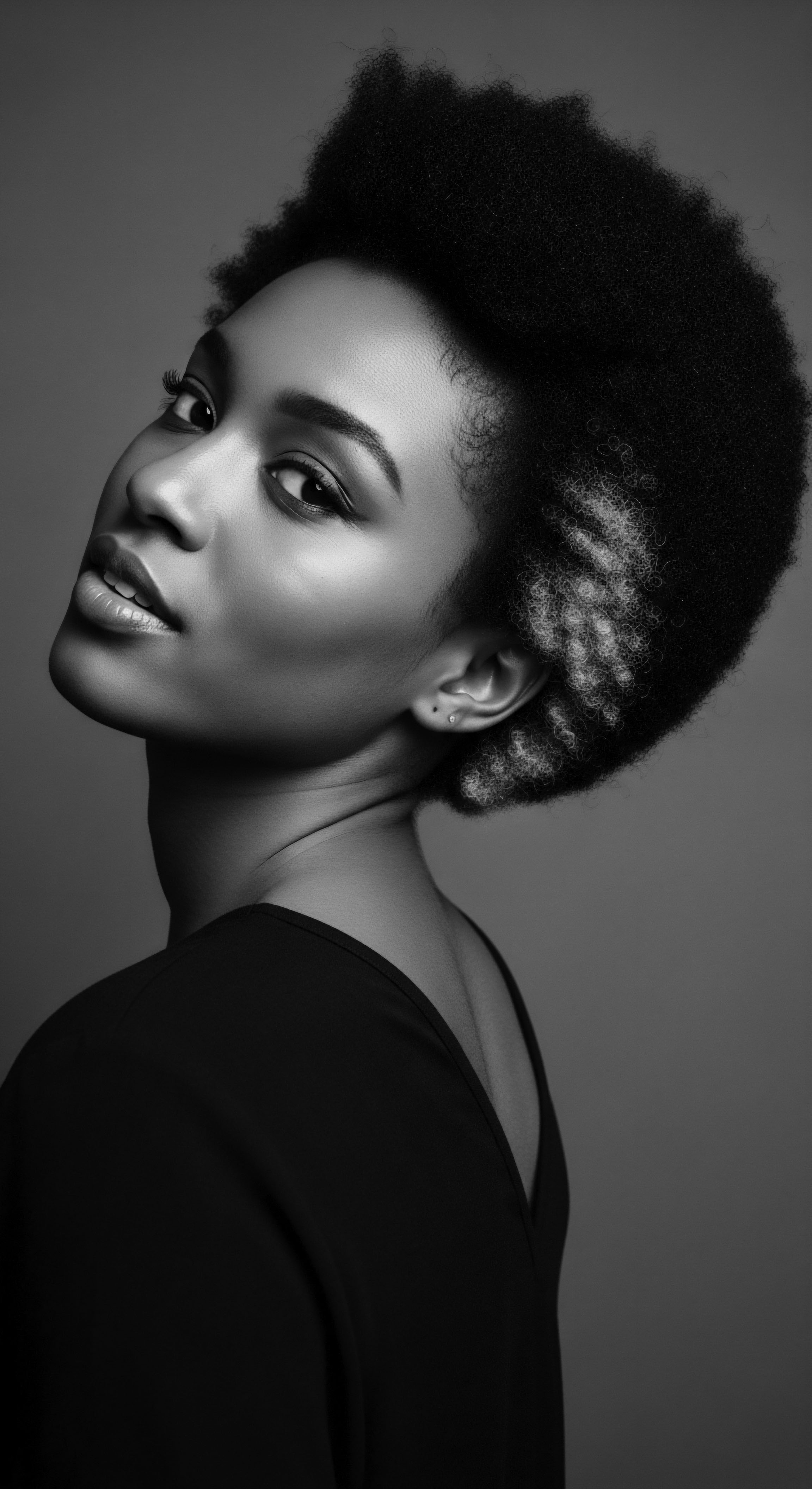
Roots
The very strands that crown us carry stories—echoes of sunlight on ancient earth, whispers of hands that tended them with reverence. For those whose hair coils and twists, refusing the linear path, this heritage runs particularly deep. It’s a living archive, each ripple and turn holding generations of wisdom. When we consider what ancient cleansing rituals informed our modern approaches to caring for textured hair, we do not merely examine historical curiosity.
We open a dialogue with our ancestors, understanding how their practical knowledge of purification laid the groundwork for the conditioning, gentle cleansing, and scalp health that defines contemporary textured hair regimens. This exploration is a journey into the fiber of our cultural memory, seeking the primal sources of care that shaped the unique needs of hair passed down through lineages.

The Biology of Blessed Coils
To truly appreciate the ancestral methods of cleansing, one must first recognize the fundamental structure of textured hair itself. Unlike straight hair, which typically has a round or oval cross-section, textured hair—ranging from waves to tight coils—possesses an elliptical or flat cross-section. This unique shape, coupled with the way the hair grows from the scalp in a helical pattern, leads to more points of curvature along the strand.
At each bend, the cuticle layer, the protective outer sheath of the hair, is slightly lifted and more exposed. This anatomical reality translates into a greater propensity for dryness and a need for gentle handling, as natural oils from the scalp struggle to travel down the coiling shaft.
Ancestral communities, without the aid of microscopes or dermatological charts, understood these inherent characteristics through observation and lived experience. Their cleansing practices, often employing natural elements, inherently compensated for these biological truths. They recognized that harsh detergents stripped moisture, leaving hair brittle, while softer, plant-derived agents cleansed without compromising the strand’s delicate balance.
This innate understanding of hair’s elemental needs, honed over millennia, forms the very foundation of how we approach textured hair care today. The ancestral approaches were, in essence, early forms of biomimicry, where methods mirrored the hair’s natural inclinations.
Ancestral cleansing rituals for textured hair reflect a profound, intuitive understanding of hair’s unique biological structure and its inherent need for gentle, moisture-preserving care.

Early Cleansing Wisdom
From the fertile soils of West Africa to the riverbanks of the Americas, early communities formulated ingenious ways to cleanse. Their solutions came directly from the natural world around them. Clay from riverbeds, rich in minerals, served as a purifying agent, drawing impurities without over-stripping.
Various plant leaves, roots, and fruits, when crushed or boiled, yielded natural suds, a gift of saponins that offered a gentle wash. These botanical agents not only cleansed but often left a nourishing residue, a testament to their multi-functional properties.
Consider, for instance, the widespread use of certain plants across the African continent. The pods of the Acacia concinna plant, commonly known as Shikakai in parts of South Asia and Africa, and the soapberries from the Sapindus genus, or Reetha, contain natural saponins that create a mild lather. These were not merely cleansers; they were conditioning agents, revered for their ability to leave hair soft and manageable.
Such botanical wisdom, passed through generations, speaks to an intricate knowledge of plant chemistry long before modern laboratories existed. The discernment of which plants offered optimal cleansing with minimal harm was a critical aspect of ancestral wellness and beauty practices, a wisdom woven into daily life.
- Clay Washes ❉ Utilizing bentonite or rhassoul clay to purify the scalp and strands, renowned for drawing out toxins while leaving moisture.
- Plant-Derived Saponins ❉ Employing parts of plants such as shikakai, reetha, or yucca root that naturally lather and cleanse gently.
- Herbal Infusions ❉ Brewing concoctions from various leaves, barks, or flowers, used as rinses to cleanse, condition, or add luster.
These methods, born from deep observation and reverence for nature, speak to an era when cleansing was not separate from nourishment. It was a holistic process, recognizing that clean hair also meant healthy hair, a concept that underpins much of today’s textured hair philosophy.

Ritual
The act of cleansing in ancient societies extended far beyond simple hygiene; it was a ritual steeped in communal practice, spiritual significance, and cultural identity. These were not solitary, hurried affairs but often communal rites, moments for intergenerational bonding and the transmission of ancestral wisdom. The rhythmic motions of mixing clays, pounding plant materials, or massaging herbal infusions into hair were meditative acts, connecting individuals to their heritage and to each other. Understanding these rituals offers a profound insight into the very soul of hair care for textured strands, revealing practices that served as prototypes for much of what we deem innovative today.

A Heritage of Purity and Purpose
Across various Black and mixed-race communities, cleansing was often intertwined with rites of passage, ceremonial preparations, or daily affirmations of self-worth. In many West African societies, the preparation and application of a cleanser could be a group activity, particularly for women, where knowledge about specific herbs, their properties, and their ceremonial uses was shared. This communal aspect ensured the continuity of traditional practices and reinforced the collective identity tied to hair adornment and care.
For instance, the creation of Black Soap, known variously as Anse Dudu (Yoruba) or Alata Samina (Twi), from the ashes of plantain skins, cocoa pods, palm oil, and shea butter, is not merely a recipe but a time-honored tradition. The process itself—the careful burning of plant materials, the precise mixing of oils—requires knowledge passed down through oral tradition. The resulting soap, deeply cleansing yet remarkably moisturizing due to its natural glycerin content and emollients, became a staple.
Its efficacy, recognized across generations, is a testament to the sophisticated understanding of natural ingredients that preceded scientific analysis. This ancestral cleansing agent is a direct precursor to the gentle, pH-balanced cleansers favored in modern textured hair care, which prioritize moisture retention above all else.
Ancient cleansing rituals, like the communal preparation of West African black soap, transcended hygiene to become sacred acts of cultural transmission, communal bonding, and identity affirmation.

What Lessons Do Ancient Cleansing Rites Hold for Today’s Practices?
The core lessons from these ancient rites are remarkably resonant with current best practices for textured hair. The emphasis on gentle cleansing, the integration of nourishing ingredients, and the consideration for scalp health were all inherent to ancestral methods. For example, the use of oils such as Palm Oil, Shea Butter, or Coconut Oil as pre-cleansing treatments, or for scalp massage before a wash, served to loosen debris and protect strands from stripping. This tradition mirrors the modern practice of Pre-Pooing, where oils or conditioners are applied before shampooing to guard against excessive moisture loss.
Similarly, the concept of rinsing hair with herbal infusions, often brewed to leave conditioning properties, is seen in the contemporary popularity of ACV Rinses (apple cider vinegar) or botanical hair teas. These rinses clarify the scalp and hair, adjust pH, and can impart beneficial compounds without the harshness of strong detergents. The ancestral wisdom did not separate cleansing from conditioning; it understood them as symbiotic aspects of holistic care.
| Ancient Practice Rooted in Heritage Using plant-derived saponins (e.g. shikakai, black soap) |
| Modern Textured Hair Care Counterpart Sulfate-free shampoos and low-lather co-washes |
| Ancient Practice Rooted in Heritage Pre-wash oil application (e.g. shea butter, palm oil) |
| Modern Textured Hair Care Counterpart Pre-poo treatments and detangling oils |
| Ancient Practice Rooted in Heritage Herbal rinses for clarity and conditioning |
| Modern Textured Hair Care Counterpart Apple cider vinegar rinses and botanical hair teas |
| Ancient Practice Rooted in Heritage Clay masks for scalp detoxification |
| Modern Textured Hair Care Counterpart Scalp scrubs and clarifying treatments with natural clays |
| Ancient Practice Rooted in Heritage These parallels underscore the enduring legacy of ancestral ingenuity in maintaining the well-being of textured hair. |

The Communal Hands of Care
In many ancient African communities, hair cleansing was not a private act but a communal one, particularly among women. Mothers, grandmothers, and aunts would gather, sharing remedies and techniques, intertwining care with conversation and story. These sessions fortified social bonds and provided a natural setting for passing down the intricacies of textured hair care, from specific plant knowledge to detangling methods. This collective approach stands in stark contrast to the often individualistic modern routine.
Yet, the spirit of shared knowledge persists in online hair communities and salons, which serve as contemporary gathering places for the exchange of textured hair wisdom, a continuity of the communal care ethos. The tender touch of one generation caring for the coils of another reinforced familial ties and cultural pride.

Relay
The continuum from ancient cleansing rituals to modern textured hair care is not merely a historical curiosity; it is a profound testament to the efficacy of ancestral practices, often validated by contemporary scientific understanding. The insights gleaned from millennia of experiential knowledge are, in many instances, being affirmed by the very chemistry and biology that explain hair at a molecular level. This intergenerational transmission of wisdom, a true relay of care across time, reveals how deeply rooted our current approaches are in the practices of those who came before.

Echoes in the Modern Regimen
Modern textured hair care is marked by a distinctive focus on moisture preservation and gentle cleansing. This emphasis is a direct echo of ancestral practices. The widespread adoption of Co-Washing (conditioner-only washing) and Low-Lather Shampoos with mild surfactants are not entirely new inventions. They mirror the very essence of ancient plant-based cleansers, which provided a gentle, non-stripping wash.
Consider the natural saponins in plants like Soapnut or Yucca. These botanical compounds cleanse by lowering surface tension, allowing water to mix with and lift dirt and oil without creating excessive foam or stripping the hair’s natural lipid barrier. Modern formulations strive for this same balance.
The ancestral understanding extended to the very environment of the scalp. Cleansing was not just for the hair fiber, but for the skin from which it grew. The use of clays, like Rhassoul Clay from the Atlas Mountains, for scalp detoxifying and purifying, finds its parallel in modern clay masks and scalp treatments. These natural agents absorb impurities and excess sebum, promoting a healthy environment for hair growth, a wisdom now scientifically supported for its ability to regulate scalp microbiota and reduce inflammation.

How Do Contemporary Cleansing Rituals Reflect Ancestral Ingenuity?
The ingenuity of ancestral cleansing rituals is reflected in several key aspects of modern textured hair care. One compelling parallel lies in the gentle manipulation of hair during cleansing. Ancient practitioners understood that excessive rubbing or tangling during washing could lead to breakage, especially for delicate coiled strands.
Their methods often involved working with hair in sections, carefully detangling with broad-toothed combs or fingers while the hair was saturated with water and a slippery cleansing agent. This mindful, sectioned approach is now a cornerstone of many modern wash-day routines for textured hair, minimizing mechanical damage.
Furthermore, the ancestral recognition of pH balance, though not articulated in scientific terms, was evident in their practices. Many plant-based cleansers and rinses naturally fall within a slightly acidic to neutral pH range, which is ideal for maintaining the integrity of the hair cuticle and preventing swelling or damage. For example, some traditional preparations from hibiscus or sour fruits would have imparted a beneficial acidity, much like the modern use of Apple Cider Vinegar Rinses to close the cuticle and add sheen after cleansing. This intuitive understanding of chemical properties speaks to a deep, empirical knowledge base.
Consider the powerful role of cultural continuity, even through periods of immense disruption. During the transatlantic slave trade, enslaved Africans carried with them invaluable knowledge of plants and their uses, including hair care. Though access to traditional materials was often limited, the ingenuity and adaptive spirit meant they sought out comparable plants in their new environments or repurposed available resources. The consistent focus on gentleness, moisture, and protective styling persisted, often serving as a quiet act of resistance and identity preservation.
For instance, the use of lye from wood ash, carefully prepared to a precise strength, was a practice in some communities for making rudimentary soaps for cleansing both body and hair (Blair, 2013). While rudimentary, the very act of creating their own cleansing agents, often from what was discarded, spoke volumes about their resilience and commitment to ancestral methods of self-care. This speaks to a historical example of adaptive cultural memory, where the ritual of cleansing became a site for maintaining connection to heritage amidst profound disempowerment.
- Low-Lather Approach ❉ Modern sulfate-free shampoos and co-washes mimic the mild saponin activity of ancient plant washes.
- Pre-Cleanse Treatments ❉ The contemporary practice of applying oils or conditioners before shampooing echoes ancestral oiling rituals that protected hair from stripping.
- Sectioning Hair ❉ Mindful division of hair into sections for washing and detangling, minimizing breakage, parallels careful ancient handling methods.
- PH Balancing Rinses ❉ Current apple cider vinegar or botanical rinses reflect the beneficial acidity of some traditional plant-based cleansers and conditioners.

The Science Affirming Ancient Ways
Modern trichology and cosmetic science increasingly affirm the wisdom embedded in ancestral cleansing rituals. The understanding of the hair cuticle’s role, the scalp microbiome, and the impact of pH on hair integrity provides scientific backing for practices once considered purely traditional. For example, the humectant properties of natural ingredients like Honey, used in some ancient formulations, are now understood for their ability to draw and hold moisture, a critical element for textured hair. Similarly, the antimicrobial properties of certain herbs, recognized for their cleansing and scalp-healing abilities centuries ago, are now isolated and celebrated in modern formulations.
The concept of skinification of hair care, treating the scalp with the same attention as facial skin, finds a strong precedent in ancient rituals. Many traditional cleansing methods focused intently on massaging the scalp, using ingredients that both cleaned and nourished the skin, understanding the direct link between a healthy scalp and thriving hair. This holistic view, where hair and scalp are treated as an interconnected ecosystem, is a direct inheritance from ancestral practices.
The ongoing research into the specific molecular compounds within traditional plants continues to validate ancestral choices. For instance, studies on aloe vera reveal its enzymatic and anti-inflammatory properties, explaining its long-standing use for soothing and cleansing the scalp (Sainz, 2019). This convergence of ancient wisdom and modern scientific validation strengthens the argument for honoring and studying these historical cleansing rituals, recognizing them not as relics of the past but as living sources of knowledge informing the future of textured hair care.

Reflection
To journey through the landscape of ancient cleansing rituals is to walk alongside the ancestors, recognizing their profound wisdom inscribed within the very fabric of our textured hair. What ancient cleansing rituals informed modern textured hair care stands as a testament to continuity—a living, breathing archive of ingenuity, resilience, and deep connection to the natural world. From the communal mixing of black soap under the African sun to the careful rinsing of strands with botanical infusions, these practices were more than acts of hygiene; they were ceremonies of self-affirmation, cultural preservation, and a recognition of hair as a sacred extension of identity.
The influence of these early cleansing methods is not merely historical; it is palpably present in the gentle surfactants of our shampoos, the conditioning properties of our co-washes, and the deliberate attention we pay to scalp health. Our modern textured hair care regimens carry the ancestral imprint, a silent acknowledgment of the efficacy of age-old wisdom. By understanding this lineage, we do not just care for our hair; we participate in a continuous conversation across generations, honoring the strands that carry the soul of our heritage. Our cleansing routines today are, in essence, a daily reaffirmation of an unbroken legacy, a mindful engagement with the enduring wisdom of those who came before.

References
- Blair, S. (2013). Hair Story ❉ Untangling the Roots of Black Hair in America. St. Martin’s Press.
- Cossé, P. G. (2014). African Hair ❉ Its Cultural and Spiritual Significance. Africa World Press.
- Lewis, L. (2009). Hair Story ❉ The Definitive Guide to African American Hair Care. Simon & Schuster.
- Sainz, J. (2019). The Science of Black Hair ❉ A Comprehensive Guide to Textured Hair Care. Createspace Independent Publishing Platform.
- Tharps, L. & Byrd, A. (2001). Hair Story ❉ Untangling the Roots of Black Hair in America. St. Martin’s Press.
- Walker, C. J. (1927). Madam C. J. Walker and the Black Hair Care Industry. A’Lelia Bundles Collection. (While not a direct scholarly text, refers to historical figures and practices).
- Anyanwu, E. C. (2013). Traditional African Hair Care Secrets. Lulu.com.
